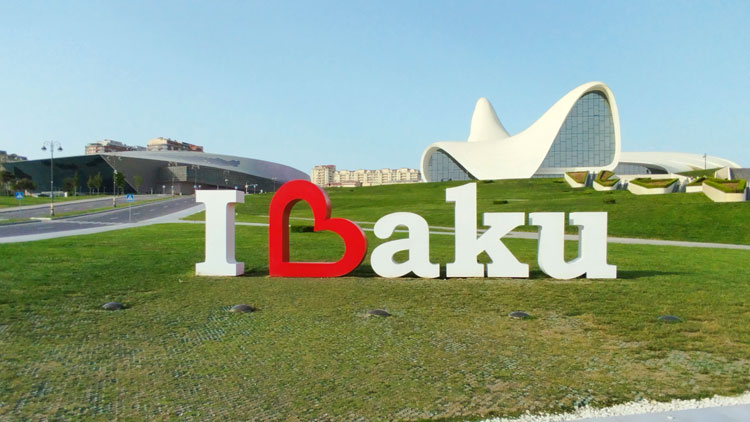Juan David Latorre
In a disorderly but symmetrical encounter, the capital of Azerbaijan, Baku, welcomes the visitor with a varied and diverse amalgam of vestiges full of ancient history, together with dazzling and beautiful skyscrapers that reflect this country’s commitment to modernity and economic and social evolution.
‘The land of fire’, as Azerbaijan is known, has in its capital, ‘The city of wind’, as Baku is called, a tourist and monumental offer adorned with a mixture of cultures, the product of its long history. Archaeological finds in Azykh, Taglar caves, Damjili, Dashsalahli, Gazma caves and other monuments, as well as the jawbone of the ancient Azikh man (Azikhantrop) dating back 300-400 thousand years, confirm that this Caucasian country is one of the oldest human settlements in the world. State traditions in the historical lands of Azerbaijan have almost 5 thousand years of history. The first state formations or ethno-political associations in the territory of Azerbaijan emerged as early as the late 4th and early 3rd century BC.

The Cimmerians and Iscythians, as well as the Sakas and the Masstae, the Achaemenid Iranian Empire, the campaigns of Alexander the Great, the occupations of the Sassanid-Iranian Empire in the 3rd century and the Arab Caliphate in the 7th century left a large Persian-speaking population and a population of Arab origin in the country, an indelible mark on the Azerbaijani people, although all this could not destroy the ancient traditions of the state of Azerbaijan. And it was not until the late 15th-early 16th century that the prominent statesman Shah Ismail Khatai succeeded in uniting all the lands of Azerbaijan under his rule. A single centralised Azerbaijani state was established.
All these historical events, along with all the subsequent confrontations, conquests and defeats up to the present day, are reflected in a stroll through the streets of Baku, where tourists can be dazzled by the 12th century Maiden’s Tower (a UNESCO World Heritage Site), full of legends from a prophecy that foretold a deadly end to the young girl at the age of 18 from a snake bite, to her suicide when her father intended to marry her.

Baku’s UNESCO-protected old town lives on, untouched by the traffic and hustle and bustle of the surrounding oil city. The winding alleys follow a medieval logic, while the stone buildings cover all eras, from the aforementioned Maiden’s Tower to the new, pseudo-classical palaces to a selection of 19th-century houses and austere mini-mosques. Added to this chaos are several caravanserais, a 15th century palace complex, a multitude of carpet shops, a few cafes and small hotels.

And all surrounded by the partly restored city wall, adorned with catapults and elements typical of other eras, a living testimony to Azerbaijan’s rich history. These ancient fortifications, dating back to the 12th century, surround Baku’s old town and offer a fascinating glimpse into the city’s medieval past. Added to this is the traditional carpet production of the Azerbaijani country, especially in Baku, where its old town is “carpeted” to the delight of tourists. The use of carpets as furniture and wall decoration is widespread, and special carpets are also woven for medical treatment, prayer, wedding ceremonies, childbirth and funeral rites. Carpet weaving is a traditional technique that is passed down orally and through practice. To bring all this art together, the beautiful new Carpet Museum was built in 1967 and refurbished in 2014. Its collection includes more than 10,000 items of ceramics, 14th-century metalwork, Bronze Age jewellery, rugs from the 17th-20th centuries, national costumes, embroidery and artwork from the Modern Age.
Mosques are scattered throughout the city of Baku, and the one built in 2014 in honour of former President Heydar Aliyev, next to the Juma Mosque, stands out from the rest.

Bazaar Square, also known as the Khanqah complex, is a historic religious-architectural complex with arcades dating back to the 12th and 13th centuries. Located on Kichik Gala Street within the Old City, this square is a treasure trove of the region’s history and culture.
And suddenly, out of this ancient artistic treasure trove emerges a totally antagonistic and modern world, to which the visitor can spend another day strolling around the skyscrapers and modern buildings of the Azerbaijani capital. All of them stand out for their grandeur, originality and beauty, but especially the Flame Towers, which are the three tallest skyscrapers in Baku, with heights of 190, 160 and 140 metres. At night they are transformed into three immense screens with the use of more than 10,000 high-power LEDs.

It highlights the diversity of building types that are mixed in Baku. Mosques and palaces from the 14th century can be seen side by side with Parisian-inspired buildings, as well as modern, avant-garde buildings.
Two buildings that sum up the modernity that Azerbaijan boasts today, the Heydar Aliyev Centre and the Baku Congress Centre, located opposite each other, deserve special mention. The former represents architectural excellence in the heart of the capital. Designed by renowned architect Zaha Hadid, this impressive building houses a wide range of cultural and leisure facilities. As well as the Congress Centre, which hosts the most important political, social, cultural and economic events in the Caucasus.

There are many monuments, squares and mosques to be seen in Baku, and it would be endless to describe their beauty. To mention just a few, the Fountain Square, Highland Park, the Mini-Venice, the Alley and the Martyrs’ Mosque, together with the monument dedicated to them, the Boulevard Promenade by the sea, the sports centres that have hosted world championships in recent times, or the largest shopping centre in all of Azerbaijan, the Deniz Mall.







